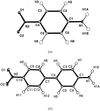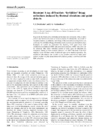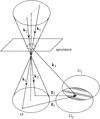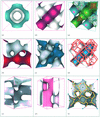issue contents
July 2000 issue

Cover illustration: Unit cell of a self-intersecting minimal surface with symmetry I432. The surface subdivides R3 into two congruent three-periodic mutually interpenetrating labyrinths with symmetry P4232. Lines of self-intersection are marked in red. See Koch [Acta Cryst. (2000), A56, 15-23].
research papers
The spectral decomposition of the compliance fourth-rank tensor of orthorhombic, tetragonal, hexagonal and cubic crystals.
Topological analysis of molecular – and crystal – charge densities of p-nitroaniline and p-amino-p′-nitrobiphenyl reveals considerable discrepancies between experimental and theoretical topologies at the bond critical points. Analysis of the differences shows the discrepancies to be mainly due to the nature of the radial functions used in the experimental multipole model.
In general, the local atomic environment becomes less symmetric owing to point defects and thermal vibrations of atoms in crystals. It is shown that, as a result of this phenomenon, the extra Bragg reflections can be excited, providing a novel method to study point defects (Ge is one of the discussed examples).
A recently developed method for fitting a Monte Carlo computer simulation model to observed single-crystal diffuse X-ray scattering data has been used to study the disorder in p-methyl-N-(p-chlorobenzylidene)aniline, C14H12ClN (ClMe), at 295 K. The short-range-order (SRO) correlation structure observed within the layers of molecules in the ab plane is typical of a frustrated lattice, where nearest- and second-nearest-neighbour effects oppose each other. Local `size-effect' strains operating on different intermolecular vectors generally reflect the tendency for distances involving Cl—Cl interactions to be longer than the observed average distances.
A new method using the coherent CBED method is proposed to distinguish the special pairs of space groups (I23 and I213) and of (I222 and I212121), which have so far been indistinguishable.
A relationship exists between factor groups of space groups and subperiodic groups. This relationship, an isomorphism between factor groups of reducible space groups and subperiodic groups, can be used in the derivation of higher-dimensional space groups, of lattices of space groups, and of irreducible representations of space groups.
A property of well phased low-resolution Fourier syntheses to reveal macromolecules as `blobs' may be successfully used for ab initio phasing of low-resolution diffraction data.
A novel method for modelling solid–solid reconstructive phase transitions, based on periodic nodal surfaces (PNS), is presented. The method allows exploration of such topological pathways in a very general fashion, and is applied to the quartz-to-tridymite transition.
The phenomenon of the polarization suppression of X-ray Umweg multiple waves in Renninger scans of crystals, showing intensity decrease due to properly chosen wavelength and polarization of incident radiation, is observed. With elliptically or linearly polarized synchrotron radiation, partial suppression of the strong Umweg interfered component provides an alternative way of enhancing the visibility of multiple-wave interference in crystals for direct phase determination.
book reviews
Free 



 journal menu
journal menu





























